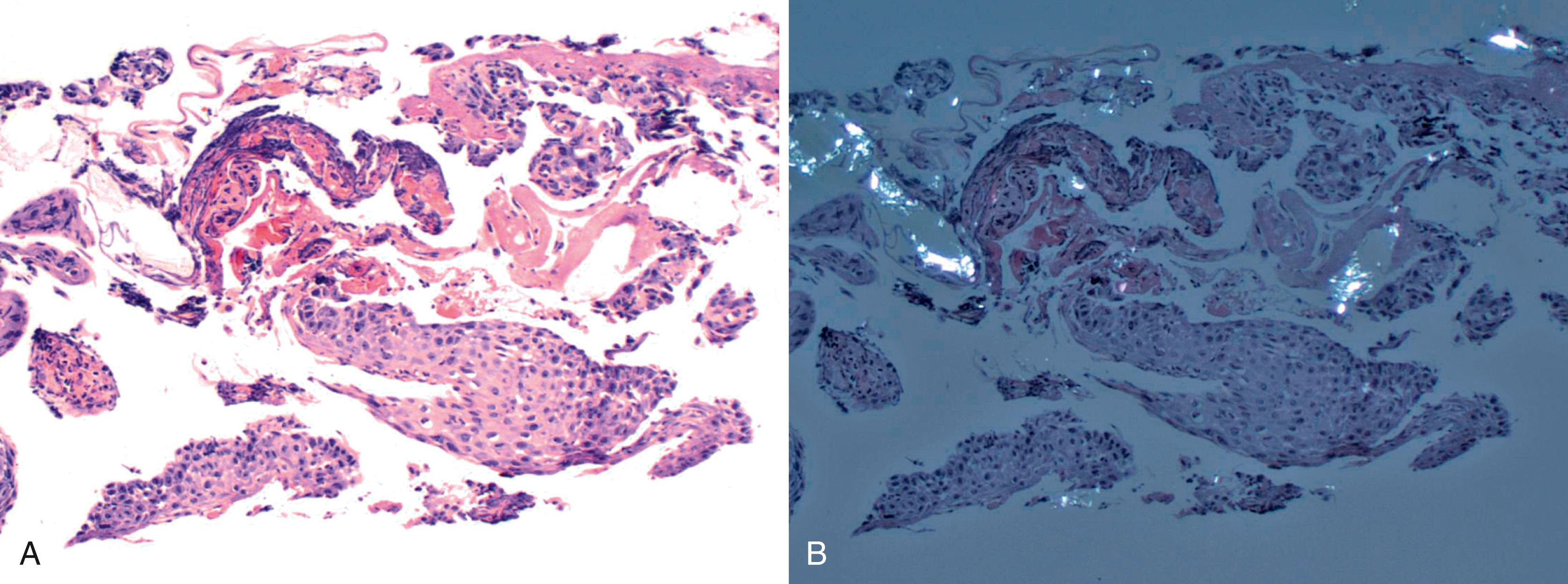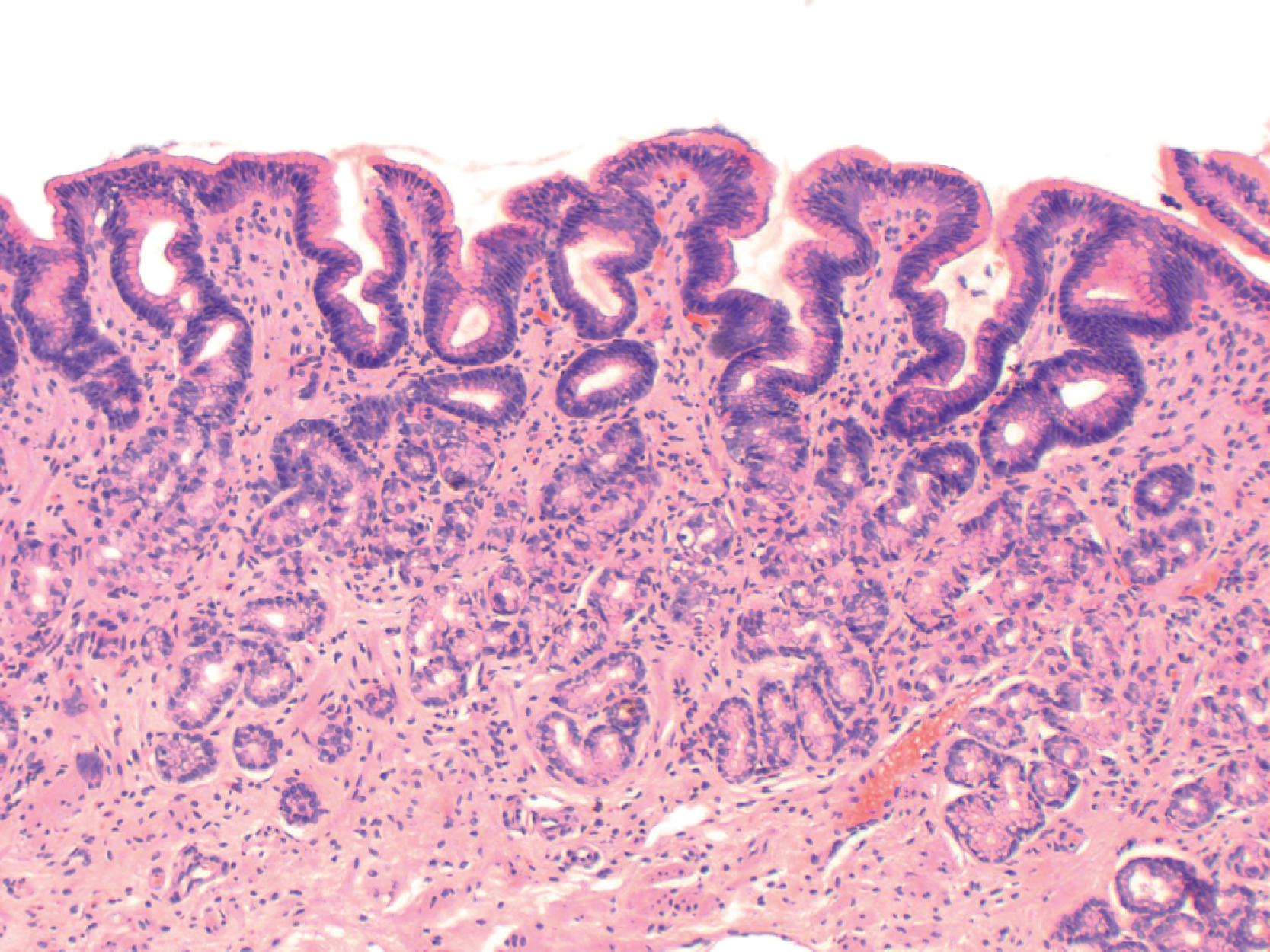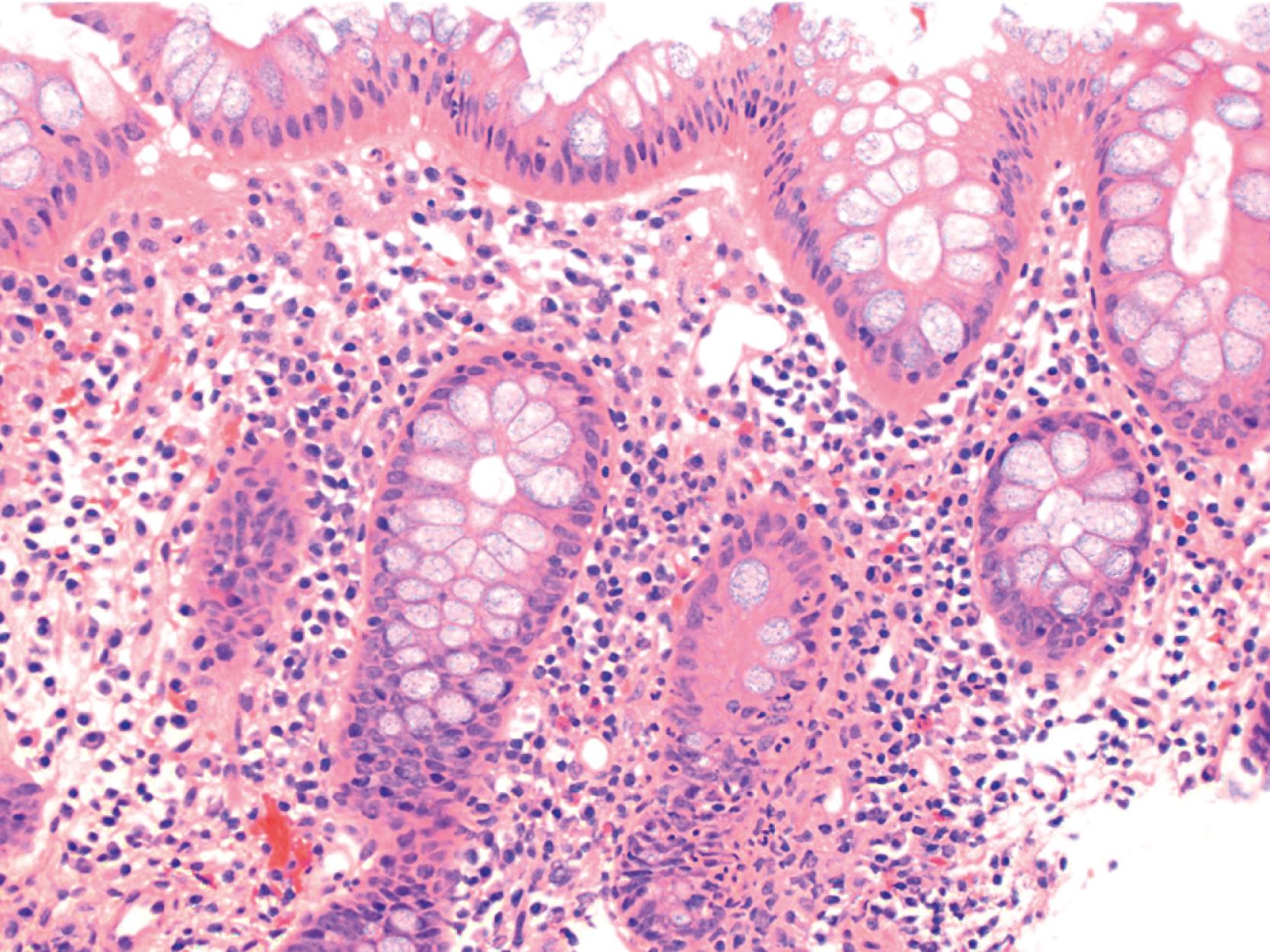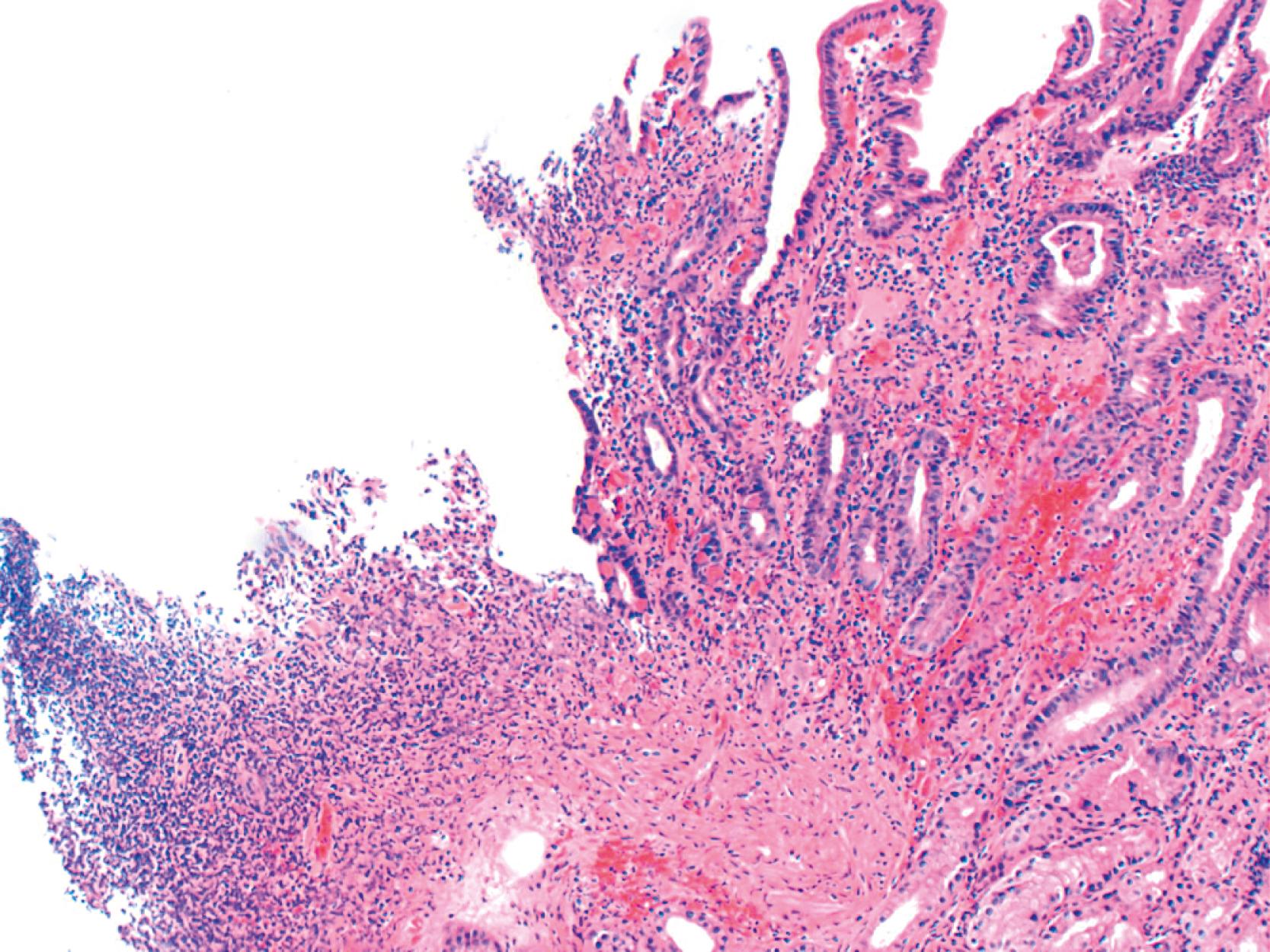Physical Address
304 North Cardinal St.
Dorchester Center, MA 02124
Given the plethora of drugs available by prescription and over the counter, and that most are administered orally, it is not surprising that many drugs can cause gastrointestinal (GI) disease. The injury caused by drugs can be due to direct toxic effects of the drug on the GI mucosa, toxic effects to the mesenchymal components of the gut, including the enteric nervous system, systemic effects of the drug, or indirect damage such as in antibiotic-associated pseudomembranous colitis. The patterns of injury associated with drugs include virtually all of the patterns of inflammatory injury described in the GI tract. Thus, in these situations, a medication history is essential to avoid confusion with other common types of inflammatory disorders, such as inflammatory bowel disease (IBD) or ischemia. Occasionally, a drug reaction may be suspected based on the specific findings in the biopsy sample, such as when crystals or pigments are identified. Rarely, histology alone is enough to implicate a specific drug without knowledge of the patient’s clinical profile.
In this chapter on drug-induced injury of the GI tract, nonspecific histological injury patterns, and the drugs associated with these patterns, are described first. Some of these patterns are organ specific, such as reactive gastropathy or pill esophagitis, whereas others are more generalizable to the entire GI tract, such as ulcers, strictures, or vasculitis. This section is followed by a discussion of specific drugs that are well known to cause GI damage, beginning with the most commonly implicated drugs, nonsteroidal antiinflammatory drugs (NSAIDs) and proton pump inhibitors (PPIs). Some of these agents produce a wide range of pathology, some of which are nonspecific and generate a differential diagnosis, whereas others produce a characteristic picture that may be more readily recognizable as a drug reaction by pathologists. Given the vast number of drugs currently available, it is impossible to be comprehensive in this chapter. However, the most common drug associations are discussed in detail.
Pill esophagitis occurs secondary to caustic injury caused by retention of a pill in the esophagus. This is often associated with failure to swallow an adequate amount of liquid with the tablet or capsule and swallowing these medications in the supine position before bedtime. The most commonly reported agents that can cause pill esophagitis include antibiotics (particularly doxycycline, tetracycline, and clindamycin), NSAIDs, potassium chloride, iron supplements, ascorbic acid, quinidine, emepronium bromide, and alendronate. , , The mechanism by which these drugs cause esophagitis differs depending on the particular agent involved. Tetracyclines, ascorbic acid, and ferrous sulfate produce acidic solutions when dissolved in water, suggesting that they produce acid burns, whereas phenytoin produces an alkaline solution and possibly alkaline burn. , Production of local hyperosmolarity by potassium chloride and intracellular poisoning after mucosal uptake by doxycycline and NSAIDs may be the mechanism of injury of these agents. , ,
Women and older patients are more often affected. , , However, the age range is wide. Different drugs are consumed by different age groups. In a review of 650 reported cases, the average age of patients who had quinidine-related esophageal injury was 60, whereas the average age of patients injured by oral antibiotics was 30. Most patients present with odynophagia, retrosternal pain, and dysphagia , , and do not have a history of esophageal dysmotility. , Complications of pill esophagitis include esophageal strictures, hemorrhage, esophageal perforation, and even death. , , , ,
Endoscopic findings include erythema, mucosal denudation, discrete ulcers or erosions, and strictures. , , , , , , , The squamous epithelium may exfoliate, forming an intraluminal cast, a condition known as esophagitis dissecans superficialis. , Sloughing esophagitis with longitudinal sloughing of the middle to distal esophagus is characteristic of esophagitis secondary to dabigatran, a thrombin inhibitor. Quinidine-induced esophageal injury occasionally manifests with exuberant exudates that mimic carcinoma. , Remnants of the pill may also be seen. The usual sites of involvement are the midesophagus at the level of the aortic arch (22 to 24 cm) and, in patients with left atrial enlargement, the distal esophagus at 30 to 35 cm. , , However, distal involvement with stricture may easily be mistaken for reflux esophagitis. , Histological evaluation shows the usual features of esophagitis, with acute inflammation, erosions or ulcers, and granulation tissue. , Polarizable crystalline material may be an important clue to the diagnosis ( Fig. 12.1 ) although it is not present in all cases. Multinucleation of squamous epithelial cells has been reported in association with alendronate-associated esophageal injury. , Perivascular edema has been described in the ulcers secondary to doxycycline. , Esophageal strictures have been described in patients taking potassium chloride, doxycycline, tetracycline, acetylsalicylic acid, ascorbic acid, phenytoin, and quinidine.

Reactive gastropathy was a condition initially thought to be specifically related to gastric mucosal injury caused by reflux of duodenal contents into the stomach and was also known as alkaline gastritis or bile reflux gastritis. , This distinctive histological entity is now considered a nonspecific response to a variety of gastric irritants, of which bile is only one. NSAIDs and alcohol are also common causes. The features of reactive gastropathy (or “chemical gastritis”) include foveolar hyperplasia with a “corkscrew” appearance to the pits, surface epithelial degeneration with cuboidalization of the foveolar glandular cells and mucin depletion, lamina propria edema, vascular congestion, a paucity of inflammatory cells, and smooth muscle hyperplasia in the lamina propria. The muscle fibers are typically oriented perpendicular from the muscularis mucosae toward the mucosal lumen ( Fig. 12.2 ). , Small foci of atrophy with pseudopyloric or intestinal metaplasia are common and may reflect ulcer repair.

Increasingly, a celiac disease–like enteropathy secondary to medications has been reported. Villous atrophy, variable lymphocytic exocytosis, and variable crypt apoptoses may mimic celiac disease, and clinical circumstances, including onset of symptoms related to initiation of the suspected medication, severe presentation, and absence of response to gluten withdrawal, may be clues to the correct diagnosis. Olmesartan and other sartans are the most widely known agents that cause this, but other agents can produce a similar picture, such as ticlopidine, idelalisib, checkpoint inhibitors, and mycophenolate mofetil.
Drugs may cause patterns of injury that mimic virtually every other known type of colitis. The patterns of colitis that suggest particular agents are listed in Table 12.1 . Eosinophilic colitis ( Fig. 12.3 ) is associated with numerous drugs, including NSAIDs, gold compounds, and carbamazepine hypersensitivity. In one series of patients undergoing colonoscopy for probable drug colitis, increased eosinophils were found in the left colon of patients taking NSAIDs, antiplatelet agents, or estroprogestinic agents, regardless of colonoscopic findings. NSAIDs are associated with increased lymphocytes and scattered neutrophils in the lamina propria, or an appearance similar to that of lymphocytic colitis. Alpha methyldopa and NSAIDs may cause a neutrophilic colitis, mimicking infection. Amoxicillin and levofloxacin have been implicated in cases of pseudomembranous colitis. Chemical colitis from glutaraldehyde, alcohol, or hydrogen peroxide can mimic ischemic colitis. Checkpoint inhibitor therapy, rituximab, mesalamine, and etanercept can cause colitis that resembles ulcerative colitis, can trigger IBD, or can exacerbate preexisting IBD.
| Pattern of Colitis | Possible Drug |
|---|---|
| Eosinophilic colitis | NSAIDs, gold, carbamazepine, antiplatelet agents, estroprogestinic agents |
| Lymphocytic colitis/collagenous colitis | NSAIDs, proton pump inhibitors, ticlopidine, ranitidine, simvastatin, flutamide, carbamazepine, sertraline, penicillin V |
| Focal active colitis | NSAIDs, oral sodium phosphate |
| Ischemic colitis | NSAIDs, glutaraldehyde, antibiotics, chemotherapy, nasal decongestants, constipation-inducing medications, laxatives, vasopressor agents, cocaine, ergotamine, serotonin agonists/antagonists including sumatriptan, high-dose estrogen and progesterone, amphetamines, digitalis, diuretics, immunomodulators such as interleukin-2 |
| Apoptotic colitis | Bowel prep with oral sodium phosphate, laxatives, chemotherapeutic agents (especially 5-fluorouracil), mycophenolate mofetil, idelalisib, NSAIDs, cyclosporine A |
| Pseudomembranous colitis | NSAIDs, amoxicillin, levofloxacin, antibiotic associated Clostridium difficile colitis |
| Immune-mediated colitis | Immune checkpoint inhibitors |
| Neutropenic colitis | Chemotherapy |

Several drugs have been implicated in the development of lymphocytic and collagenous colitis, including NSAIDs, lansoprazole, selective serotonin reuptake inhibitors (SSRIs), ticlopidine, ranitidine, simvastatin, flutamide, carbamazepine, sertraline, and penicillin V. , Checkpoint inhibitor colitis may resemble either lymphocytic or collagenous colitis.
The clinical presentation of drug-induced ischemia varies depending on the offending agent, the mesenteric vessels involved, the interval between exposure of the drug and clinical presentation, and the general status of the patient. Segmental involvement is typical. The histology is identical to that of ischemia due to other causes. It may reveal ulceration, necrosis, edema, and fibrosis, depending on the stage of injury. Drugs associated with ischemic colitis include antibiotics, NSAIDs, chemotherapeutic agents such as the taxanes, nasal decongestants, constipation-inducing medications, laxatives, vasopressor agents, cocaine, ergotamine, serotonin agonists/antagonists including sumatriptan, oral contraceptives, amphetamines, digitalis, diuretics, and immunomodulators such as interleukin-2. , The mechanisms by which drugs cause ischemia vary. For instance, estrogens may result in vascular thromboses, ergotamine may cause vascular spasm leading to proctitis with the development of shallow ulcers, cocaine is a potent sympathomimetic mesenteric vasoconstrictor that produces severe intestinal ischemia, diuretics may cause extracellular fluid volume changes that favor peripheral circulation over mesenteric circulation, and antibiotics may cause hypersensitivity vasculitis. Chemical colitis, such as from glutaraldehyde or alcohol enemas, can also appear histologically indistinguishable from ischemic colitis.
Focal active colitis (FAC) is defined as cryptitis that involves one or a few crypts, and is associated with epithelial injury and often a surrounding mononuclear infiltrate in an otherwise unremarkable colonic biopsy ( Fig. 12.4 ). It is historically associated with Crohn’s disease. In a 1997 study involving patients without a prior history of IBD, Greenson et al. found that most symptomatic patients with FAC had acute self-limited or infectious colitis, whereas FAC in asymptomatic patients carried no clinical significance. None developed Crohn’s disease. However, 19 of 42 patients in this study were taking NSAIDs, leaving open the possibility that NSAIDs were the cause of FAC. Subsequently, FAC was reported by Driman et al. in patients given oral sodium phosphate as a bowel prep regimen, and they suggested that the idiopathic cases in Greenson’s report may have been due to bowel prep.

Drug-induced pseudo-obstruction, or paralytic ileus, rarely comes to the attention of surgical pathologists, because the usual treatment is discontinuation of the offending agent. However, complications such as megacolon or perforation may ensue, necessitating surgical intervention. Many drugs can damage the myenteric plexus, causing loss of neurons and schwannosis. Narcotics, phenothiazines, tricyclic antidepressants, anthraquinone laxatives, anti-Parkinson’s drugs, clonidine, calcium channel blockers, and vincristine are associated with pseudo-obstruction.
Numerous drugs can cause erosions or ulcers in the GI tract. These may be encountered as a single isolated lesion, with nonspecific features, or as part of a more widespread ischemic, cytotoxic, or inflammatory process ( Fig. 12.5 ). Potassium chloride was one of the earliest reported agents implicated in causing ulcers and even strictures in the GI tract, including the stomach. , Certainly the most common drug to result in gastric and other GI tract ulcers are NSAIDs. These drugs not only damage the mucosa, but they also retard ulcer healing. Other drugs associated with GI ulcers include alendronate, doxycycline, chemotherapeutic agents, corticosteroids, ferrous sulfate, sodium polystyrene sulfonate (Kayexalate), ergot, gold compounds, and colchicine. , , ,

Although drug-induced perforation is uncommon, it may complicate severe ischemic, toxic, or inflammatory colitis of any cause. Intestinal perforation has been reported in cancer patients taking bevacizumab, a monoclonal antibody directed against vascular endothelial growth factor (VEGF) that is used in the treatment of metastatic colon cancer, non–small cell lung cancer, ovarian cancer, renal cell carcinoma, and other cancers. From a meta-analysis of the literature, intestinal perforations occur in about 1.1% of patients who have taken bevacizumab, with a mortality rate of 8.8%. Perforations also occur in about 1.3% of patients on VEGF receptor tyrosine kinase inhibitors, with a 28.6% mortality rate. Intestinal perforation has also been reported in association with temsirolimus, immunosuppressive medications (steroids, azathioprine), NSAIDs, , slow-release potassium chloride, flucytosine, neuroleptic medications, tocilizumab, and other medications. In addition, corticosteroids, opioids, and NSAIDs are associated with an increased risk of complications in diverticular disease, including perforation.
Esophageal strictures have been described in patients taking potassium chloride, doxycycline, tetracycline, acetylsalicylic acid, ascorbic acid, phenytoin, and quinidine. Several drugs have been implicated in intestinal strictures such as potassium chloride and pancreatic enzyme replacement. A dramatic example of intestinal and colonic strictures secondary to drugs is “diaphragm disease” due to NSAIDs (see further section on NSAIDs).
Several drugs have been associated with increased apoptotic bodies in the crypt epithelium and occasionally associated with dilated crypts containing apoptotic debris. These drugs include penicillin V, mycophenolate mofetil, checkpoint inhibitors, methotrexate, capecitabine, etanercept, and infliximab ( Fig. 12.6 ). , ,

Drug-induced vasculitis can affect the blood vessels of the GI tract, and result in ischemia. Quinidine, ranitidine, clarithromycin, angiotensin-converting enzyme inhibitors, acetylsalicylic acid, carbidopa/levodopa, ampicillin, chlorpromazine, and ciprofloxacin have all been implicated in Henoch-Schönlein purpura (HSP). GI involvement by HSP can manifest as diarrhea and vomiting and can be complicated by obstruction or perforation. GI involvement is most common in the second part of the duodenum, but it can also affect the esophagus, stomach, colon, and rectum. Discrete coinlike lesions that coalesce or hemorrhagic and ecchymotic lesions have been described.
Biopsy shows granulocytes in the wall of small arterioles or venules with necrosis of the vessel wall similar to findings in leukocytoclastic vasculitis ( Fig. 12.7 ).

Another form of vasculitis that may be related to drugs is lymphocytic enterocolic phlebitis (see Chapter 11 for details), a condition that affects the right colon, small intestine, or sigmoid colon, often with ischemic consequences. In lymphocytic enterocolic phlebitis, veins show perivascular lymphocytic inflammation, with subendothelial aggregation, thickening of the vessel wall, and occasionally fibrinoid necrosis of the blood vessel ( Fig. 12.8 ). In some cases, the inflammation is sparse, and myointimal hyperplasia is more prominent. Rare cases have shown associated lymphocytic infiltrate in the mucosa and epithelium analogous to lymphocytic colitis or collagenous colitis. , Lymphocytic enterocolic phlebitis was initially described in three patients who had taken rutoside, a phlebotonic drug commonly used in Europe to treat varicose veins. Although another reported case also occurred in a patient on rutoside, subsequent cases have not corroborated an association with this drug. Reports of patients who had taken the antiandrogen drug flutamide and developed this form of vasculitis , support the notion that a hypersensitivity reaction to drugs explains some cases of lymphocytic enterocolic phlebitis.

Various drugs may promote infections of the GI tract. The association of antibiotics with pseudomembranous colitis caused by Clostridium difficile is the most well-known example. Necrotizing enterocolitis, neutropenic enterocolitis, or other infections, including GI candidiasis, may develop in people who have received chemotherapy. Immunosuppressive therapies predispose patients to opportunistic infectious organisms such as cytomegalovirus. ,
Patients with iron overload on deferoxamine therapy are predisposed to develop Yersinia infection. Both the iron overload and its treatment contribute to the risk of infection. Iron is an essential growth factor for bacteria, including Yersinia . Normally, free iron in the host is too low to support the growth of virulent organisms . For bacterial pathogens, successful infection relies on invading cells, in part to acquire iron. Strains that have the Yersinia high-pathogenicity island are able to synthesize the siderophore yersiniabactin, enabling them to acquire iron from host proteins. Transfusion with its resultant iron load increases the amount of iron available to the organism, and iron overload impairs neutrophilic phagocytic activity. Furthermore, the addition of exogenous siderophores, such as deferoxamine, makes iron more available for the organism. The combination of iron overload and deferoxamine therapy increases the risk of Yersinia infection; in one study, invasive Yersinia infection was diagnosed in 14 patients with β-thalassemia at a frequency 5000-fold greater than that in the general population, and all but two patients were taking deferoxamine at the time of diagnosis of infection.
PPIs may also indirectly predispose to infection. Gastric acid plays a role in the killing of bacteria. Reducing gastric acid may reduce the ability to eliminate bacterial pathogens. An association between PPI use and bacterial gastroenteritis, primarily with Campylobacter and Salmonella, has also been reported. Similarly, the reduced ability to kill bacterial spores may explain a reported association between PPI use and C. difficile infection. ,
Become a Clinical Tree membership for Full access and enjoy Unlimited articles
If you are a member. Log in here